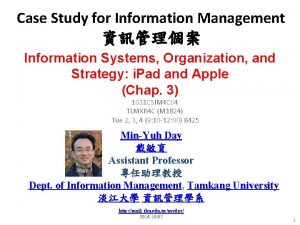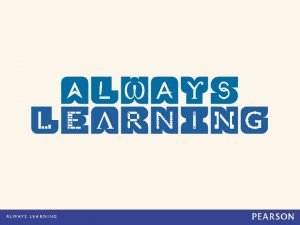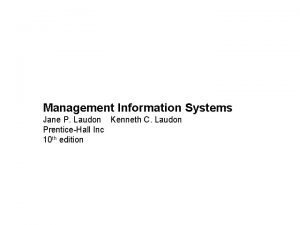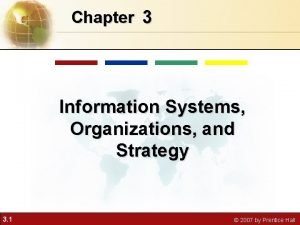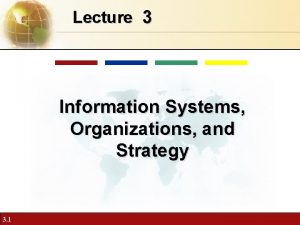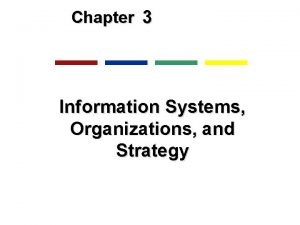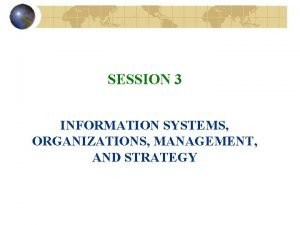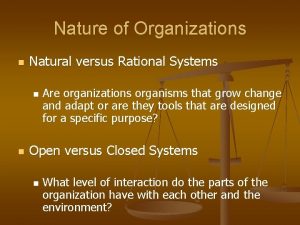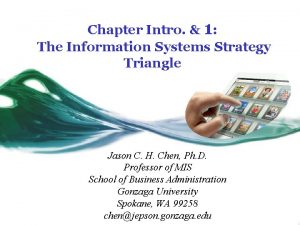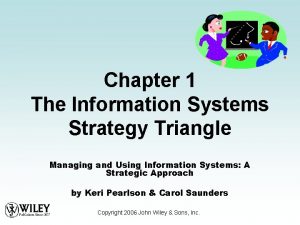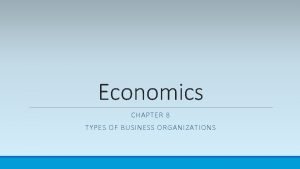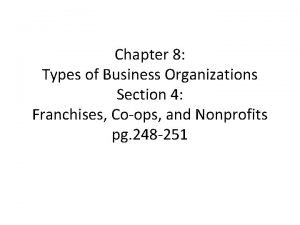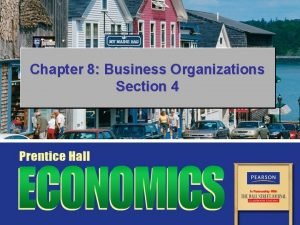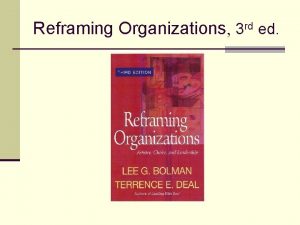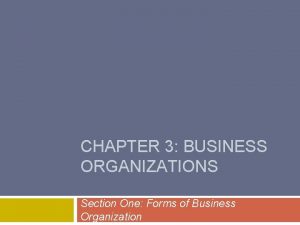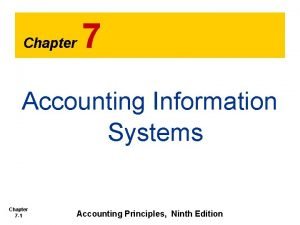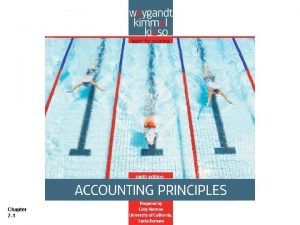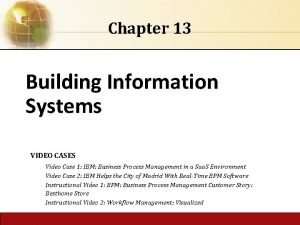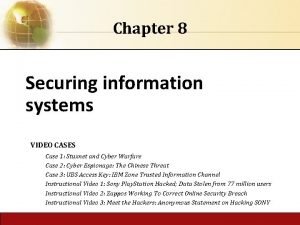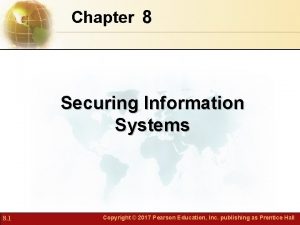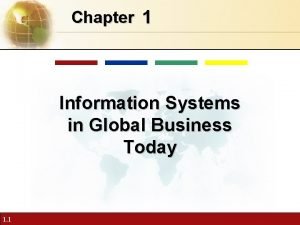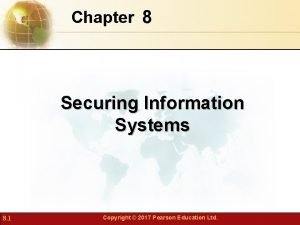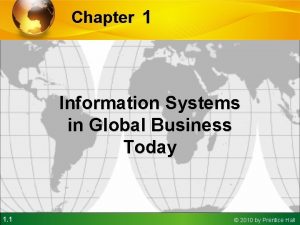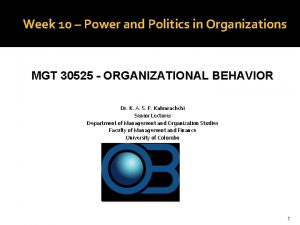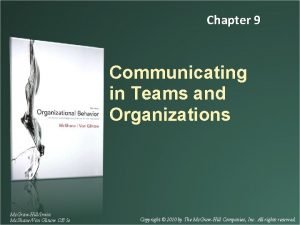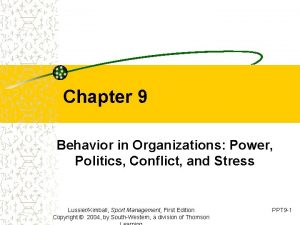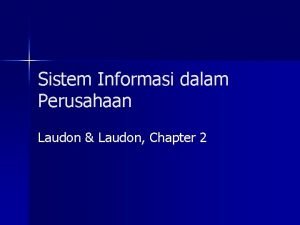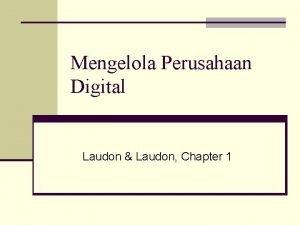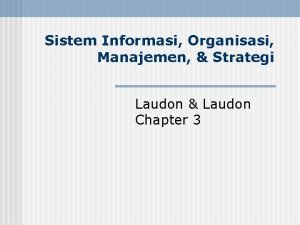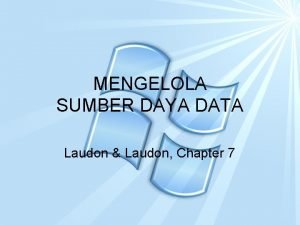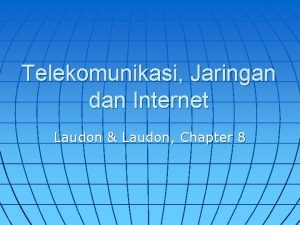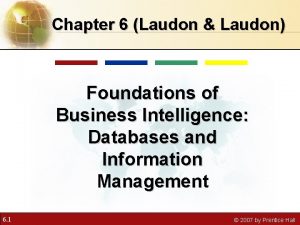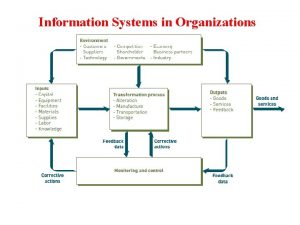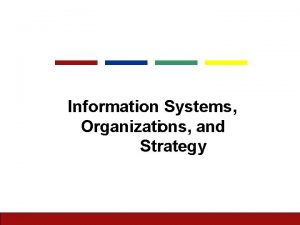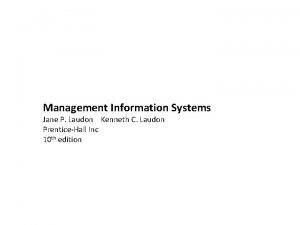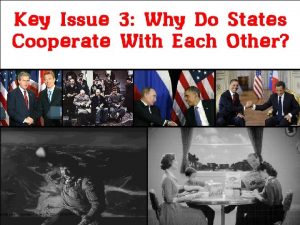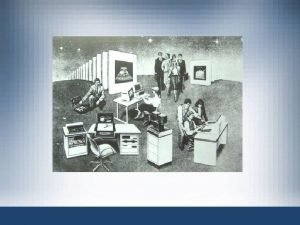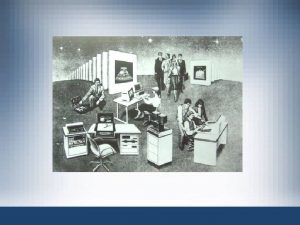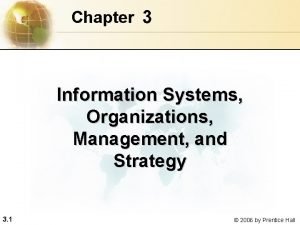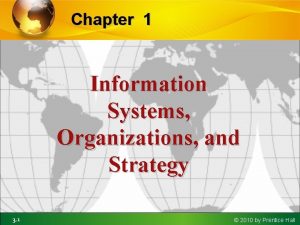Information Systems Organizations and Strategy Chapter 3 Laudon













































- Slides: 45

Information Systems, Organizations, and Strategy Chapter 3 Laudon & Laudon 12 th ed.

Learning Objectives 1. Which features of organizations do managers need to know about to build and use information systems successfully? What is the impact of information systems on organizations? 2. How does Porter’s competitive forces model help companies develop competitive strategies using information systems? 3. How do the value chain and value web models help businesses identify opportunities for strategic information system applications? 4. How do information systems help businesses use synergies, core competencies, and network-based strategies to achieve a competitive advantage? 5. What are the challenges posed by strategic information systems and how should they be addressed?

Organizations and Information Systems. • Information technology and organizations influence one another • Complex relationship influenced by organization’s structure, business processes, politics, culture, environment, and management decisions

Organizations and Information Systems • What is an organization? • Technical definition: � � • Stable, formal social structure that takes resources from environment and processes them to produce outputs • A formal legal entity with internal rules and procedures, as well as a social structure • Behavioral definition: • A collection of rights, privileges, obligations, and responsibilities that is delicately balanced over a period of time through conflict and conflict resolution The behavioral view emphasizes group relationships, values, and structures as shown in Figure 3 -3. These two definitions are not contradictory. The technical definition focuses on thousands of firms in competitive markets while the behavioral definition focuses on individual firms and an organization’s inner workings.

The Technical Microeconomic Definition of the Organization

The Behavioral View of Organizations

Organizations and Information Systems • Features of organizations • All modern organizations share some characteristics, such as: • Use of hierarchical structure • Accountability, authority in system of impartial decision making • Adherence to principle of efficiency • Other features include: Routines and business processes and organizational politics, culture, environments and structures

Organizations and Information Systems • Routines and business processes • Routines (standard operating procedures) • Precise rules, procedures, and practices developed to cope with virtually all expected situations • Business processes: Collections of routines • Business firm: Collection of business processes � Technology becomes a substitute for traditional capital like � labor, buildings, and machinery.

Organizations and Information Systems • Organizational politics • Divergent viewpoints lead to political struggle, competition, and conflict • Political resistance greatly hampers organizational change

Organizations and Information Systems • Organizational culture: • Encompasses set of assumptions that define goal and product • What products the organization should produce • How and where it should be produced • For whom the products should be produced • May be powerful unifying force as well as restraint on change

Organizations and Information Systems � Corporate culture is the collective behavior of people using common corporate vision, goals, shared values, beliefs, habits, working language, systems, and symbols. � It is interwoven with processes, technologies, learning and significant events. In addition, different individuals bring to the workplace their own uniqueness, knowledge, and ethnic culture. � So, corporate culture encompasses moral, social, and behavioral norms of your organization based on the values, beliefs, attitudes, and priorities of its members.

Organizations and Information Systems � Organizational culture has been defined as the pattern of basic assumptions that a given group has invented, discovered, or developed in learning to cope with its problems of external adaptation and internal integration, and that have worked well enough to be considered valid, and, therefore, to be taught to new members as the correct way to perceive, think, and feel in relation to those problems” (Vavra, 1997)

Organizations and Information Systems • Organizational environments: • Organizations and environments have a reciprocal relationship • Organizations are open to, and dependent on, the social and physical environment • Organizations can influence their environments • Environments generally change faster than organizations • Information systems can be instrument of environmental scanning, act as a lens

� Environments shape what organizations can do, but organizations can influence their environments and decide to change environments altogether. � Information technology plays a critical role in helping organizations perceive environmental change and in helping organizations act on their environment.

Reciprocal Relationship: organization and IS

Organizations and Information Systems • Disruptive technologies • Technology that brings about sweeping change to businesses, industries, markets • Examples: personal computers, word processing software, the Internet, the Page. Rank algorithm • First movers and fast followers • First movers – inventors of disruptive technologies • Fast followers – firms with the size and resources to capitalize on that technology � Sustaining technologies q technologies that maintain and rejuvenate the performance improvement of product and services that use them.

Organizations and Information Systems • Organizational structure • Five basic kinds of structure • Entrepreneurial: Small start-up business • Machine bureaucracy: Midsize manufacturing firm • Divisionalized bureaucracy: Fortune 500 firms • Professional bureaucracy: Law firms, school systems, hospitals • Adhocracy: Consulting firms

Organizations and Information Systems • Other Organizational Features • Goals • Constituencies • Leadership styles • Tasks • Surrounding environments

How Information Systems Impact Organizations and Business Firms • Economic impacts • IT changes relative costs of capital and the costs of information • Information systems/ technology is a factor of production, like capital and labor • IT affects the cost and quality of information and changes economics of information • Information technology helps firms contract in size because it can reduce transaction costs (the cost of participating in markets) • Outsourcing

How Information Systems Impact Organizations and Business Firms • Transaction cost theory • Firms seek to economize on cost of participating in market (transaction costs) • IT lowers market transaction costs for firm, making it worthwhile for firms to transact with other firms rather than grow the number of employees

How Information Systems Impact Organizations and Business Firms � The Transaction Cost Theory of the Impact of Information Technology on the Organization

How Information Systems Impact Organizations and Business Firms • Agency theory: • Firm is nexus of contracts among selfinterested parties requiring supervision • Firms experience agency costs (the cost of managing and supervising) which rise as firm grows • IT can reduce agency costs, making it possible for firms to grow without adding to the costs of supervising, and without adding employees

Organizations and Information Systems • Organizational and behavioral impacts • IT flattens organizations • Decision making pushed to lower levels • Fewer managers needed (IT enables faster decision making and increases span of control) • Postindustrial organizations • Organizations flatten because in postindustrial societies, authority increasingly relies on knowledge and competence rather than formal positions

How Information Systems Impact Organizations and Business Firms � Flattening Organizations

How Information Systems Impact Organizations and Business Firms • Organizational resistance to change • Information systems become bound up in organizational politics because they influence access to a key resource – information • Information systems potentially change an organization’s structure, culture, politics, and work • Most common reason for failure of large projects is due to organizational and political resistance to change

Using Information Systems to Achieve Competitive Advantage At the highest level of abstraction, a firm is characterized by its strategy, its culture, and its current infrastructure o o A firm’s strategy represents the manner in which it intends to achieve its objectives A firm’s culture is a collection of beliefs, expectations and values shared by members of an organization. It represents the way a firm does business- practices that are deemed appropriate in one organization.

The competitive platform � The Internet and the many information technologies and innovations built on the Internet infrastructure has dramatically changed the competitive landscape for almost all companies. � The driving force is the phenomenon called Web 2. 0, the mobile platform, and the 3 -dimensional immersive environment. � The network economy created allows ubiquitous global networks to drastically reduce geographic and time constraints; enables organizations to compete on a global basis.

Using Information Systems to Achieve Competitive Advantage � the consequence is that the global competitive playing field has been leveled leading to an unprecedented degree of globalization. � The most apparent change brought about by the network economy took place at the front end of company interaction with clients i. e. the business- to-consumer space.

Using Information Systems to Achieve Competitive Advantage � The most common reason large IT projects fail is not the failure of technology, but because of organizational and political resistance to change. � People simply don’t like change and will resist it in a variety of ways.

Using Information Systems to Achieve Competitive Advantage • • Why do some firms become leaders within their industry? Michael Porter’s competitive forces model • Provides general view of firm, its competitors, and environment • Five competitive forces shape fate of firm • Traditional competitors • New market entrants • Substitute products and services • Customers • Suppliers


• Traditional competitors • All firms share market space with competitors who are continuously devising new products, services, efficiencies, switching costs • New market entrants • Some industries have high barriers to entry, e. g. computer chip business • New companies have new equipment, younger workers, but little brand recognition

• Substitute products and services • Substitutes customers might use if your prices become too high, e. g. i. Tunes substitutes for CDs • Customers • Can customers easily switch to competitor’s products? Can they force businesses to compete on price alone in transparent marketplace? • Suppliers • Market power of suppliers when firm cannot raise prices as fast as suppliers

• Four generic strategies for dealing with competitive forces, enabled by using IT • Low-cost leadership • Product differentiation • Focus on market niche • Strengthen customer and supplier intimacy

• Business value chain model • Views firm as series of activities that add value to products or services • Highlights activities where competitive strategies can best be applied • Primary activities vs. support activities • At each stage, determine how information systems can improve operational efficiency and improve customer and supplier intimacy • Utilize benchmarking, industry best practices

The value chain model

• Value web: • Collection of independent firms using highly synchronized IT to coordinate value chains to produce product or service collectively • More customer driven, less linear operation than traditional value chain � The value web is a networked system that can synchronize the value chains of business partners within an industry to respond rapidly to changes in supply and demand.

The Value Web

• Information systems can improve overall performance of business units by promoting synergies and core competencies • Synergies • When output of some units used as inputs to others, or organizations pool markets and expertise • Example: merger of Bank of NY and JPMorgan Chase • Purchase of You. Tube by Google • Core competencies • Activity for which firm is world-class leader • Relies on knowledge, experience, and sharing this across business units

• Network-based strategies • Take advantage of firm’s abilities to network with each other • Include use of: • Network economics • Virtual company model • Business ecosystems

• Network economics • Traditional economics: Law of diminishing returns • The more any given resource is applied to production, the lower the marginal gain in output, until a point is reached where the additional inputs produce no additional outputs • Network economics: • Marginal cost of adding new participant almost zero, with much greater marginal gain • Value of community grows with size • Value of software grows as installed customer base grows • Virtual company strategy • Virtual company uses networks to ally with other companies to create and distribute products without being limited by traditional organizational boundaries or physical locations

• Business ecosystems • Industry sets of firms providing related services and products • Microsoft platform used by thousands of firms for their own products • Wal-Mart’s order entry and inventory management system • Keystone firms: Dominate ecosystem and create platform used by other firms • Niche firms: Rely on platform developed by keystone firm • Individual firms can consider how IT will enable them to become profitable niche players in larger ecosystems

An Ecosystem Strategic Model

Using Systems for Competitive Advantage: Management Issues • Sustaining competitive advantage • Because competitors can retaliate and copy strategic systems, competitive advantage is not always sustainable; systems may become tools for survival • Performing strategic systems analysis • What is structure of industry? • What are value chains for this firm? • Managing strategic transitions • Adopting strategic systems requires changes in business goals, relationships with customers and suppliers, and business processes

� Section 3. 5, “Hands-On MIS”. � Management Decision Problems
 Management information system case study
Management information system case study Management information system case study
Management information system case study Laudon laudon schoder
Laudon laudon schoder Kenneth c. laudon jane p. laudon
Kenneth c. laudon jane p. laudon Chapter 3 information systems organizations and strategy
Chapter 3 information systems organizations and strategy Information systems organizations and strategy
Information systems organizations and strategy Information systems, organizations, and strategy
Information systems, organizations, and strategy Information systems, organizations, and strategy
Information systems, organizations, and strategy Information systems organizations and strategy
Information systems organizations and strategy E-commerce presence map
E-commerce presence map Kenneth c. laudon
Kenneth c. laudon Natural system organization
Natural system organization Business strategy triangle
Business strategy triangle Information systems strategy
Information systems strategy Introduction to management and organizations
Introduction to management and organizations Chapter 4 ethical issues
Chapter 4 ethical issues Chapter 4 ethical and social issues in information systems
Chapter 4 ethical and social issues in information systems Chapter 8 business organizations
Chapter 8 business organizations Chapter 8 section 4 other organizations
Chapter 8 section 4 other organizations Chapter 8 section 4 other organizations
Chapter 8 section 4 other organizations Reframing organizations chapter 3 summary
Reframing organizations chapter 3 summary Chapter 3 business organizations
Chapter 3 business organizations Functions of an information system
Functions of an information system Chapter 8 securing information systems
Chapter 8 securing information systems Chapter 8 securing information systems
Chapter 8 securing information systems Chapter 7 accounting information systems
Chapter 7 accounting information systems Chapter 7 accounting information systems
Chapter 7 accounting information systems Dfd ch 13
Dfd ch 13 Securing information systems
Securing information systems Principles of information systems
Principles of information systems Fundamentals of information systems
Fundamentals of information systems What are the challenges to global information systems
What are the challenges to global information systems Chapter 8 securing information systems
Chapter 8 securing information systems Chapter 1 information systems in global business today
Chapter 1 information systems in global business today Introduction management information system
Introduction management information system Chapter 8 securing information systems
Chapter 8 securing information systems Chapter 7 accounting information systems
Chapter 7 accounting information systems Information systems in global business today
Information systems in global business today Corporate strategy vs business strategy
Corporate strategy vs business strategy Level strategy aggregate planning example
Level strategy aggregate planning example Power and politics in organizations
Power and politics in organizations Vhwo
Vhwo Compare and contrast business organizations
Compare and contrast business organizations Formal groups fulfill both and functions in organizations.
Formal groups fulfill both and functions in organizations. Persuasive communication
Persuasive communication Power, politics and conflict in organizations
Power, politics and conflict in organizations
